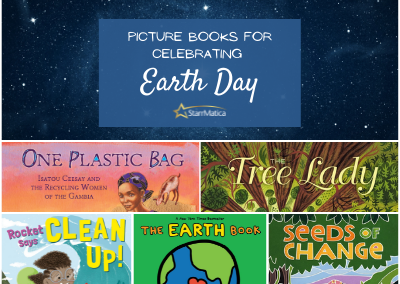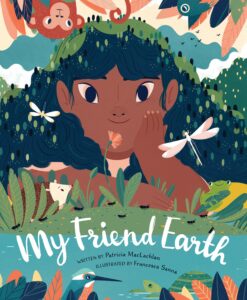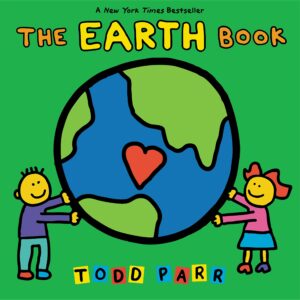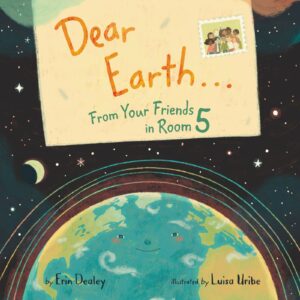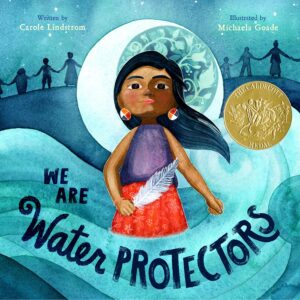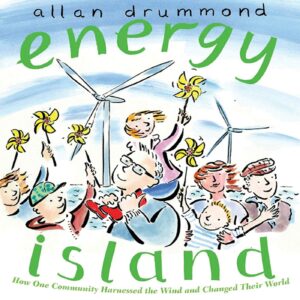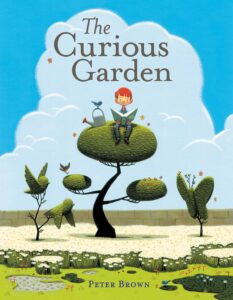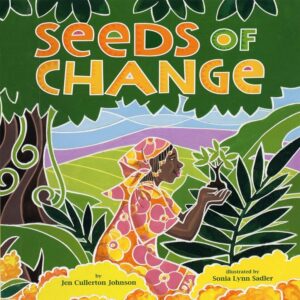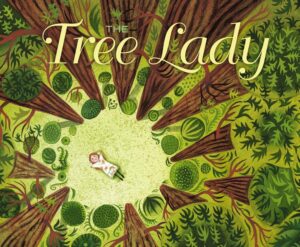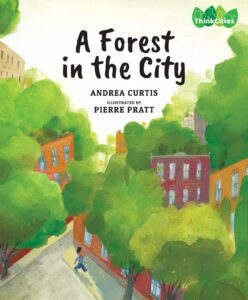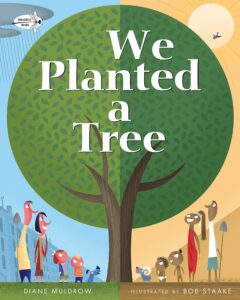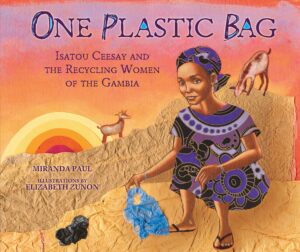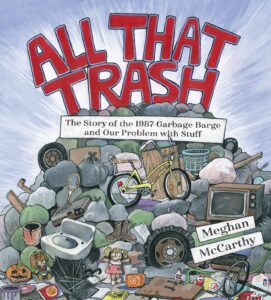Every year on April 22, we celebrate Earth Day. The first Earth Day movement started in 1970 as a response to growing concern over air pollution and public health. Today, Earth Day is widely recognized as the largest secular observance in the world!* Each year, more than a billion people use the day of action to spark change in human behavior and help create global, national and local policy changes
As teachers, we try to talk about Earth Day on April 22 and what kids can do to help the Earth, but it quickly gets forgotten as the school year winds to a close and other curriculum gets pushed ahead on the priority list. Can you relate?
We’ve decided to write this blog post in September so instead of waiting until April to talk about the Earth, you can use these picture books to inspire discussion and action throughout the entire school year! An added bonus? More of these amazing picture books will be available to check out from your library if you don’t wait until April to do so!
Here are just a few of our favorite picture books for celebrating Earth Day:
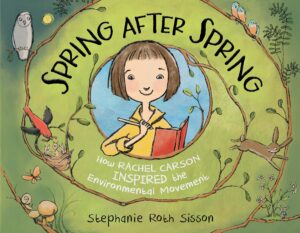 Spring After Spring: How Rachel Carson Inspired The Environmental Movement by Stephanie Roth Sisson
Spring After Spring: How Rachel Carson Inspired The Environmental Movement by Stephanie Roth Sisson
What better way to start our Earth Day picture book list than with Rachel Carson! After all, we have her to thank for inspiring the Earth Day movement. Rachel Carson, a famous biologist and writer, released her book Silent Spring in 1962. It challenged the status quo and made people think twice about the chemicals they were using everyday. It quickly became a bestseller, selling more than 500,000 copies in 24 countries as it raised public awareness and concern for living organisms, the environment and the links between pollution and public health. Just a few years later in 1970, the first Earth Day movement was launched.
Description: Spring after spring, year after year, Rachel Carson watched and listened to the world around her. When she noticed how quiet everything had become she started asking questions and looking for answers. What she found was disturbing – the chemicals that people were using everyday and were told were safe for the environment were in fact incredibly harmful. So she decided to do something about it. Readers will feel inspired by her bravery and honesty.
Questions to explore: What did Rachel Carson observe that caused her to be concerned, and have you seen anything similar in your own environment? Analyze the graphic organizer on page 23 in the book. Use cause and effect statements to describe how one chemical can have a negative influence on a whole web of life.
My Friend Earth by Patricia MacLachlan
Description: With beautiful die-cut pages and drool-worthy illustrations, this book celebrates the Earth and all the wonderful things she does for us – tends to animals big and small, pours down rain, sprinkles snow, and protects the tiny seeds waiting for spring. It’s hard to read this book and NOT fall in love with our friend Earth and feel inspired to be a good friend in return!
Questions to explore: This book, along with many cultures, view Earth as female – “Mother Earth” – why do you think this is? How does thinking about the Earth as a friend help us want to protect it and take care of it in return? What are some other things Earth does for us that you would add to the list in this book? Why?
The Earth Book by Todd Parr
Description: In classic Todd Parr style, this colorful and lively book about the Earth does not disappoint! Written in first person, the narrator tells us all the things they do to help take care of the Earth and why, in a wonderful cause and effect way: “I turn off the faucet while I brush my teeth and use less water for my baths because I love the fish, and I want the oceans to stay blue.” This is a great book to read aloud any time, but especially when talking about Earth Day!
Questions to explore: Analyze one or more of the cause and effect relationships mentioned in the book with your class. For example, the narrator says they take the bus and ride their bike because “I love the stars and want the air to be clear so I can see them sparkle.” What exactly does this mean? How does doing those things help make the air clear and the stars more visible? What additional effects would you add to the causes in the book? What additional cause and effect statements do you think should be added?
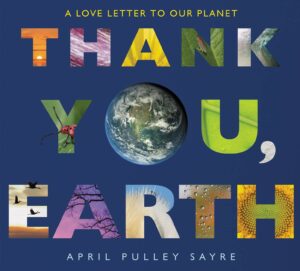 Thank You, Earth: A Love Letter To Our Planet by April Pulley Sayre
Thank You, Earth: A Love Letter To Our Planet by April Pulley Sayre
Description: With beautiful photography and simple language, this book focuses on all the things the Earth provides that we should be thankful for – from the tiniest ladybug to the tallest tree! This book provides a great opportunity to talk about the vastness of our planet and how to think about everything in a positive light, even being thankful for the things that sting, and the lives that end.
Questions to explore: Think of everything the Earth gives us. What are you most thankful for? What are some other things Earth does for us that you would add to the list in this book? Why?
Dear Earth… From Your Friends In Room 5 by Erin Dealey
Description: Written in a back-and-forth style of letters between a classroom of kids and the Earth, we learn about all the ways the kids are helping take care of their planet. Cleverly nicknamed “The Earth Heroes” by the Earth, these kids plant trees, start a school garden, inspire their cafeteria to compost, and much more. Filled with tangible ideas of ways to be an Earth Hero, this book inspires all of us to take care of the Earth all year long, not just on April 22nd!
Questions to explore: If you could write a letter to the Earth, what would you say? What do you think the Earth would say in return?
We Are Water Protectors by Carole Lindstrom
Description: A tribute to Native resilience, this story honors the Standing Rock Water Protectors who protested the Dakota Access Pipeline. The Indigenous author-and-illustrator team brings to life the idea that water connects us all and affects us all. Readers are invited to stand up for environmental justice: we need to be stewards of the Earth to help protect those who cannot fight for themselves.
Questions to explore: What water sources are in your community? Are they in danger? What are some ways you could help protect those water sources?
Energy Island: How One Community Harnessed the Wind by Allan Drummond
Description: A narrative tale and a science book in one, this inspiring true story is about the people who live on the Danish island of Samso and have accomplished something extraordinary – in just ten years they have reduced their carbon emissions by 140% and become almost completely energy independent.
Questions to explore: What steps could you take to conserve energy in your homes and communities? Why do you think the people of Samso were so successful in their efforts? How could that success be translated to other communities?
Books about plants and trees:
The Curious Garden by Peter Brown
Description: A story about a curious boy named Liam who happens across a struggling garden trying to grow on an abandoned railway and decides to help it grow, never quite imagining the effect it would have as time passes by.
Questions to explore: What would happen if an entire city decided to truly cooperate with nature? How would that city change? How would it all begin?
Seeds Of Change: Planting A Path To Peace by Jen Cullerton Johnson
Description: This book brings to life the empowering story of Wangari Maathai, the first African woman and environmentalist to win a Nobel Peace Prize, who helped save the land in Kenya one tree at a time.
Questions to explore: How does Wangari Maathai embrace the notion that one person can make a difference? How did her work help others change their environments?
The Tree Lady: The True Story of How One Tree-Loving Woman Changed a City by H. Joseph Hopkins
Description: Katherine Olivia Sessions used her degree in science to turn San Diego from a desert into a leafy green oasis.
Questions to explore: Why was Kate successful in her mission to turn San Diego into a place full of trees? How could Kate’s methods be applied to another location in modern times? How would the method be the same? How would it be different?
A Forest in the City by Andrea Curtis
Description: An incredibly thorough and accurate book about the history of trees in cities, the different purposes they serve, and the many challenges they face.*
Questions to explore: Write a plan for including more trees in your city. Why are they important? Where should they be placed? What things need to be considered before planting trees in a city?
*This book is long and may not be suitable as a read-aloud from start to finish in one sitting. It’s a great book to provide background information for a teacher, or you can pick and choose which pages to read to your students, or read this over several days.
We Planted a Tree by Diane Muldrow
Description: This simple yet beautiful poem is about two different families from two different places in the world – Brooklyn, NY, USA and Kenya, Africa – who plant a tree in their yard. The poem follows the families and the trees as they grow and flourish, adding beauty to their neighborhood, enriching the soil, and providing shade. This is a perfect book to pair with the Seeds of Change book mentioned above as the family who plants a tree in Kenya is a direct nod towards the Green Belt Movement started by Wangari Maathai.
Questions to explore: Do you think we need trees in our environment? Why or why not? Can one tree make the world better? How?
Trash / Recycling focused books:
One Plastic Bag: Isatou Ceesay and the Recycling Women of the Gambia by Miranda Paul
Description: Plastic bags are cheap and easy to use. But what happens when a bag breaks or is no longer needed? In Gambia, people simply dropped the bags and went on their way. The bags accumulated in piles alongside roads. To solve the problem, some bags were burned, some were buried, but nothing seemed to work. Something had to change, and Isatou Ceesay was that change! She finds an inventive way to rid her village of the piles of plastic bag pollution. This inspirational true story shows how one person’s actions really can make a difference in our world.
Questions to explore: Does your town have a plastic problem? What solutions can you brainstorm to solve a plastic problem in your town?
All That Trash : The Story Of The 1987 Garbage Barge And Our Problem With Stuff by Meghan McCarthy
Description: All That Trash is the true story of the infamous Mobro 4000 garbage barge and how it became a national sensation and raised environmental awareness about the need to recycle.
Questions to explore: What are some things you can do to not accumulate so much trash? Can you think of some ways we can get rid of your trash that isn’t harmful to our environment?
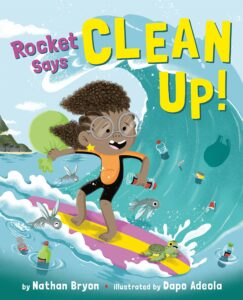 Rocket Says Clean Up! by Nathan Bryon
Rocket Says Clean Up! by Nathan Bryon
Description: While on a family vacation visiting her grandparents in Jamaica, Rocket finds a baby turtle caught in plastic. That’s when she notices that the entire beach is littered with plastic, but no one else seems to notice or care! With some help, Rocket helps organize a beach cleanup event and through her actions, helps remind all of us to clean up the environment and help protect the animals that share our world.
Questions to explore: Rocket’s grandpa said the whales stopped visiting the islands. Why do you think this is? Why do you think the people on the beach didn’t notice or didn’t care about the garbage littered everywhere? What “clean-up” project could you begin in your town?
If you are a StarrMatica Texts: Science Your Way subscriber, you can check out the texts below that align with our Earth Day focus. Remember, each 1st – 5th grade text has multiple reading levels so all of your students can read the same content independently.
- Kindergarten: Bottle It Up; Talking Trash; Helping the Planet; Taking Care of Earth
- Second grade: From This to That; From Trash to Treasure
- Third grade: Protecting the Giant Pandas; Saving the Giant Pandas
- Fourth grade: Curious Clouds and CFCs; A Race Toward Ozone Recovery; Fossil Fuels and Clean Energy; Plants Power Our Future, Powering the World with the Sun; Save the Earth with Wind Power; Harnessing the Wind
- Fifth grade: Cool Composting!; Create A Compost!; Does Farming Help or Harm the Earth?; Why Are Forests Disappearing?
Not a subscriber? Click here for a free trial to access the texts above.
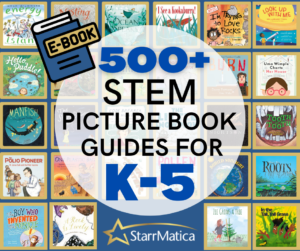 And if you are looking for additional picture books for your science classroom, check out the Perfect Picture Book Pairing Series that includes one-page guides with activities and discussion questions for hundreds of STEM-themed picture books aligned to every NGSS performance expectation!
And if you are looking for additional picture books for your science classroom, check out the Perfect Picture Book Pairing Series that includes one-page guides with activities and discussion questions for hundreds of STEM-themed picture books aligned to every NGSS performance expectation!
CLICK HERE TO PREVIEW THE PERFECT PICTURE BOOK PAIRING EBOOKS
*Source: https://www.earthday.org/history/

